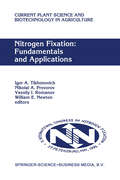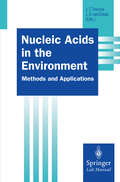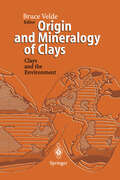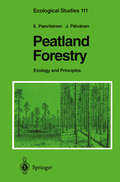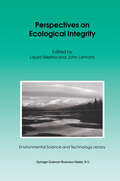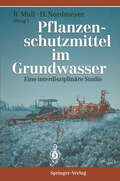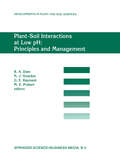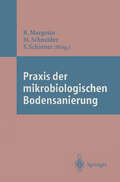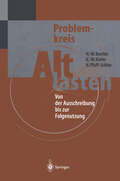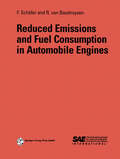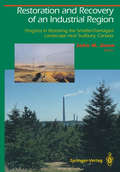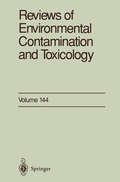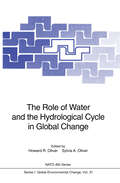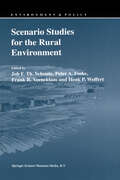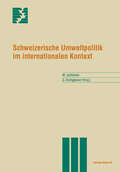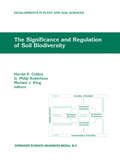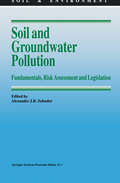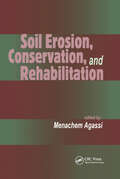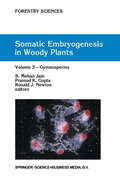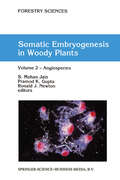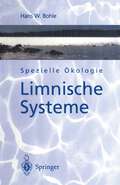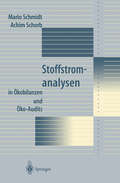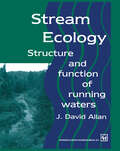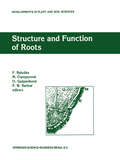- Table View
- List View
Nitrogen Fixation: Proceedings of the 10th International Congress on Nitrogen Fixation, St. Petersburg, Russia, May 28—June 3, 1995 (Current Plant Science and Biotechnology in Agriculture #27)
by Igor A. Tikhonovich Nikolai A. Provorov Vassily I. Romanov William E. NewtonNitrogen fixation research is presented as a rapidly developing, synergistic area of modern science, using the methods of, and accumulating data from, many fundamental branches of biology and chemistry. These include catalytic mechanisms, protein structure and function, molecular organization of genes and the regulation of their activities, biochemistry of plants and microorganisms, the signalling and surface interactions between organisms, microbial taxonomy and evolution, formal and population genetics, and ecology. The relationships between biological nitrogen fixation research and different branches of applied biology are addressed and analyzed, such as: the monitoring of genetically engineered microorganisms, selection of plant-associated microbes, plant breeding, increasing the protein content of crops, providing ecologically safe food production, and diminishing the chemical pollution of the environment. Immediate impacts and long-term prospects for nitrogen fixation research are presented: both fundamentals and applications.
Nucleic Acids in the Environment (Springer Lab Manuals)
by Jack T. Trevors J. Dick Van ElsasMolecular biological techniques such as DNA/RNA extraction and purification, and especially the polymerase chain reaction, PCR, are rapidly gaining interest also in related fields, such as microbiology or environmental sciences. They offer new approaches and opportunities for the determination of microbial cells, DNA and RNA from soils, roots, rhizospheres, sediments and aquatic environments. Detailed protocols for these applications are described in this manual.
Origin and Mineralogy of Clays: Clays and the Environment
by BruceVeldeOrigin and Mineralogy of Clays, the first of two volumes, lays the groundwork for a thorough study of clays in the environment. The second volume will deal with environmental interaction. Going from soils to sediments to diagenesis and hydrothermal alteration, the book covers the whole spectrum of clays. The chapters on surface environments are of great relevance in regard to environmental problems in soils, rivers and lake-ocean situations, showing the greatest interaction between living species and the chemicals in their habitat. The book is of interest to scientists and students working on environmental issues.
Peatland Forestry: Ecology and Principles (Ecological Studies #111)
by Eero Paavilainen Juhani PäivänenPerspectives on Ecological Integrity (Environmental Science and Technology Library #5)
by JohnLemons LauraWestraConcepts of ecological integrity have recently been proposed to facilitate enhanced protection of biological and ecological resources against the threat of human activities. The promotion of ecological integrity as a basis for public policy and decision making stems from scientists and others concerned about the threats of human activities to ecosystems and species, and from philosophers attempting to derive a more suitable ethic to guide the relationships between humans and the non-human environment. Although ecological integrity has been proposed as a norm for public policy and decision making, the concept is relatively new and therefore the underlying scientific and philosophical rationales have not been fully developed. This book offers a number of perspectives to stimulate and inform future discussion on the importance and consequences of ecological integrity for science, morality and public policy. Audience: Environmental professionals, whether academic, governmental or industrial, or working in the private consultancy sector. Also suitable as an upper-level reference text.
Pflanzenschutzmittel im Grundwasser: Eine interdisziplinäre Studie
by P. W. Boochs H. LiethUnter Einbehiehung von Ergebnissen nationaler und internationaler Arbeitsgruppen faßt das vorliegende Buch die gesammelten Erkenntnisse zusammen.
Plant-Soil Interactions at Low pH: Proceedings of the Third Intenational Symposium on Plant-Soil Interactions at Low pH, Brisbane, Queensland, Australia, 12–16 September 1993 (Developments in Plant and Soil Sciences #64)
by R. A. Date N. J. Grundon G. E. Rayment M. E. ProbertThe understanding of plant-soil interactions in acid soils is important for improved food production in many parts of the world. The context of the book touches on basic and applied aspects of the physics, chemistry and biology of acid soils and their effect on growth of plants. It contains a large section on management of acid soils for plant (food) production and on socioeconomic aspects of management of acid soils. This is important because a large portion of the world's acid soils occurs in less developed countries. Plant-Soil Interactions at Low pH: Principles and Management contains a substantial number of papers, including nine invited reviews, presented at the Third International Symposium of Plant-Soil Interactions at Low pH. The major themes include chemistry and physics of acid soils, microbial and faunal activity in acid soils, mechanisms of acid tolerance of plants, selection and breeding of acid-tolerant plants, diagnosis and correction of acid soil infertility, socioeconomic aspects of acid soil management and management systems for agriculture, horticulture and forestry on acid soils.
Praxis der mikrobiologischen Bodensanierung
by Rosa Margesin Manfred Schneider Franz SchinnerAltlasten und rezente Kontaminationen durch Unfälle und menschliches Fehlverhalten stellen eine Gefährdung der Biosphäre dar. Zum Schutz von Mensch, Tier und Pflanze müssen Boden, Wasser und Luft von anorganischen und organischen Schadstoffen möglichst freigehalten werden. Für die Sanierung von Böden stehen dabei unterschiedliche Technologien zur Verfügung. Die Vorteile einer mikrobiologischen Bodensanierung liegen in einer hohen Umweltverträglichkeit des Verfahrens, das durch minimalen Energieeinsatz und ohne Schaffung neuer Entsorgungsprobleme die Elimination und auch Mineralisation der Schadstoffe ermöglicht.
Problemkreis Altlasten: Von der Ausschreibung bis zur Folgenutzung
by Hans-Walter Borries Karl-Werner Kiefer Herbert Pfaff-SchleyReduced Emissions and Fuel Consumption in Automobile Engines
by Fred Schäfer Richard van BasshuysenOver the last several years, there has been much discussion on the interrelation of CO2 emissions with the global warming phenomenon. This in turn has increased pressure to develop and produce more fuel efficient engines and vehicles. This is the central topic of this book. It covers the underlying processes which cause pollutant emissions and the possibilities of reducing them, as well as the fuel consumption of gasoline and diesel engines, including direct injection diesel engines. As well as the engine-related causes of pollution, which is found in the raw exhaust, there is also a description of systems and methods for exhaust post treatment. The significant influence of fuels and lubricants (both conventional and alternative fuels) on emission behavior is also covered. In addition to the conventional gasoline and diesel engines, lean-burn and direct injection gasoline engines and two-stroke gasoline and diesel engines are included. The potential for reducing fuel consumption and pollution is described as well as the related reduction of CO2 emissions. Finally, a detailed summary of the most important laws and regulations pertaining to pollutant emissions and consumption limits is presented. This book is intended for practising engineers involved in research and applied sciences as well as for interested engineering students.
Restoration and Recovery of an Industrial Region: Progress in Restoring the Smelter-Damaged Landscape Near Sudbury, Canada (Springer Series on Environmental Management)
by John M. GunnSudbury, Ontario is one of the world's most polluted areas. A century of industrial activities has resulted in thousands of acidified lakes and vast areas of denuded land. This book describes, in a manner accessible to a wide audience, the damage and the efforts at environmental restoration at Sudbury which resulted in its winning a United Nations award in 1992 for land reclamation. The book has been written by a distinguished group of contributors, ranging from experts in acid rain and land reclamation to environmental engineers and toxicologists.
Reviews of Environmental Contamination and Toxicology: Continuation of Residue Reviews (Reviews of Environmental Contamination and Toxicology #144)
by George W. WareInternational concern in scientific, industrial, and governmental communi ties over traces of xenobiotics in foods and in both abiotic and biotic envi ronments has justified the present triumvirate of specialized publications in this field: comprehensive reviews, rapidly published research papers and progress reports, and archival documentations. These three international pUblications are integrated and scheduled to provide the coherency essential for nonduplicative and current progress in a field as dynamic and complex as environmental contamination and toxicology. This series is reserved ex clusively for the diversified literature on ''toxic'' chemicals in our food, our feeds, our homes, recreational and working surroundings, our domestic animals, our wildlife and ourselves. Tremendous efforts worldwide have been mobilized to evaluate the nature, presence, magnitude, fate, and toxi cology of the chemicals loosed upon the earth. Among the sequelae of this broad new emphasis is an undeniable need for an articulated set of authoritative publications, where one can find the latest important world literature produced by these emerging areas of science together with docu mentation of pertinent ancillary legislation. Research directors and legislative or administrative advisers do not have the time to scan the escalating number of technical publications that may contain articles important to current responsibility. Rather, these individu als need the background provided by detailed reviews and the assurance that the latest information is made available to them, all with minimal literature searching. Similarly.
The Role of Water and the Hydrological Cycle in Global Change (Nato ASI Subseries I: #31)
by Howard R. Oliver Sylvia A. OliverWater is an extremely important factor in global environmental change. Water influences the processes causing change. The human and economic consequences of changes in the water system can be very significant. The aim of this NATO Advanced Study Institute was to present a state-of-the-art assessment of the role of water in global change, ranging from a consideration of atmospheric processes to the social and political impacts of changes in water resources. Many initiatives have recently been developed, such as international conferences and research programmes in particular themes, but there was still a need for information from these diverse activities to be brought together. One of the aims of the ASI was to encourage cross-fertilization between the various disciplines looking at water in the global system. This book contains the expanded written versions of the lectures presented during the AS! held in Italy in May/June 1994. It falls into two basic parts. The first twelve chapters cover the role of water in the climate system and climate modelling. Various areas of the water balance including global budgets, the effect of each element of the water balance on regional and global climates, and procedures used to model hydrological processes at all scales are discussed. Precipitation, ice, lake, groundwater, land surface and atmospheric considerations are included together with hydrological process linkage to climate models. Ocean effects were not covered as they were considered to be outside the scope of this particular AS!.
Scenario Studies for the Rural Environment: Selected and edited Proceedings of the Symposium Scenario Studies for the Rural Environment, Wageningen, The Netherlands, 12–15 September 1994 (Environment & Policy #5)
by Job F. Th. Schoute Peter A. Finke Frank R. Veeneklaas Henk P. WolfertRural areas need to fulfil a large variety of functions and to accommodate many activities. The complexity of the problems, limited funds, and the almost irreversible character of some interventions result in a compelling need to evaluate ex ante the effects of alternative solutions for designation of land, for measures to develop infrastructure, and for soil and water management. Scenario studies are undertaken to help manage the complexity, to place bounds on uncertainties, and to create new visions. After an overview of the nature, variety and scope of scenario studies, the book illuminates various European examples and reviews, under the following headings: regional soil and water management; nature development and landscape quality; rural planning and the future of regions.
Schweizerische Umweltpolitik im internationalen Kontext (Themenhefte Schwerpunktprogramm Umwelt)
by Maren Jochimsen Gebhard KirchgässnerGerade für ein hochentwickeltes Land wie die Schweiz mit - im internationalen Ver gleich - recht hohem Umweltstandard ergeben sich heute die grössten Umweltgefahren aus internationalen bzw. globalen Umweltproblemen: der Abbau der Ozonschicht sowie die möglichen Konsequenzen einer Erwärmung der Erdatmosphäre seien als wichtigste Beispiele genannt. Dagegen scheint sich die Erkenntnis, dass nicht nur der Zustand der natürlichen Umwelt, sondern auch die Möglichkeiten und Chancen der schweizerischen Umweltpolitik nicht unabhängig davon sind, was im Ausland geschieht, im politischen Raum nur sehr allmählich durchzusetzen. Umweltpolitik wird noch viel zu häufig als reine Innenpolitik betrachtet; eine 'Umweltaussenpolitik' findet kaum statt. Aber auch in der (sozial-)wissenschaftlichen Forschung werden Umweltprobleme häufig als rein nationale Angelegenheiten angesehen: In neueren Übersichten zur ökonomischen Theorie der Umwelt finden sich beispielsweise kaum Hinweise auf die internationale Dimension dieser Probleme und die sich daraus ergebenden Bedingungen für Lösungsansätze. Vor diesem Hintergrund war es sinnvoll, dass im Rahmen des Schwerpunktprogramms Umwelt des Schweizerischen Nationalfonds die drei Projekte, die sich mit internationalen Aspekten schweizerischer Umweltpolitik beschäftigten, im koordinierten Projekt "Interna tionaler Kontext der schweizerischen Umweltpolitik" zusammengefasst wurden, als dessen Sprecher Prof. Dr. GEBHARD KIRCHGÄSSNER (Hochschule St. Gallen) fungierte. Es handelt sich dabei um die Einzelprojekte "Umweltrelevante Auswirkungen des europäischen Integra tionsprozesses in der Schweiz - Vorschläge für flankierende Massnahmen zur Eindämmung ökologisch unerwünschter Effekte" unter der Leitung von Dr. CHRISTIAN HANSER (Brugger, Hanser und Partner, Zürich), "Die Möglichkeiten und Grenzen einer internationalen Um weltpolitik der Schweiz" von PD Dr.
The Significance and Regulation of Soil Biodiversity: Proceedings of the International Symposium on Soil Biodiversity, held at Michigan State University, East Lansing, May 3–6, 1993 (Developments in Plant and Soil Sciences #63)
by Harold P. Collins G. Philip Robertson Michael J. KlugThe sustainability of both natural and managed ecosystems is strongly influenced by soil biological processes. A major question in soil biology and ecosystem ecology is the extent to which these processes are affected by the function and structure of the soil's biotic community. The Significance and Regulation of Soil Biodiversity presents the discussions of a group of soil biologists and ecosystem ecologists in which they synthesize available information, present innovative methodologies, and develop cross-taxa and cross-habitat collaborations to advance our understanding of soil biodiversity. The volume addresses the extent and regulation of soil biodiversity and describes initial approaches to the linking of soil biodiversity and ecosystem function. Audience: Researchers and students in a wide range of environmental scientific disciplines.
Soil and Groundwater Pollution: Fundamentals, Risk Assessment and Legislation (Soil & Environment #4)
by Alexander J. B.ZehnderSCOPE, the Scientific Committee on Problems of the Environment, was established by the International Council of Scientific Unions (ICSU) in 1969 as an international, non to governmental, non-profit organisation with the mandate - advance knowledge of the influence of humans on their environment, as well as the effects of these environmental changes upon people, their health and their welfare with particular attention to those influences and effects which are either global or shared by several nations; - to serve as a non-governmental, interdisciplinary and international council of scien tists and as a source of advice for the benefit of governments and intergovernmental and non-governmental bodies with respect to environmental problems. SCOPE has been established because critical environmental concerns call for a thor ough evaluation of the issues at stake, an assessment of their consequences at global and regional levels and the formulation of possible solutions. Through its activities SCOPE identifies available knowledge, then synthesizing it to point out where gaps and uncertainties exist, and to recommend where efforts should be concentrated to develop explanations and solutions.
Soil Erosion, Conservation, and Rehabilitation
by Agassi,Discusses the latest information regarding the processes and mechanisms responsible for runoff and erosion by water in arable lands--detailing state-of-the-art water and soil conservation methods. Elucidates the rehabilitation of agricultural lands depleted by human activity.
Soil Erosion, Conservation, and Rehabilitation
by Agassi,Discusses the latest information regarding the processes and mechanisms responsible for runoff and erosion by water in arable lands--detailing state-of-the-art water and soil conservation methods. Elucidates the rehabilitation of agricultural lands depleted by human activity.
Somatic Embryogenesis in Woody Plants: Volume 3: Gymnosperms (Forestry Sciences #44-46)
by S. Mohan Jain Pramod P. K. Gupta R. J. NewtonSomatic Embryogenesis in Woody Plants: Volume 2 — Angiosperms (Forestry Sciences #44-46)
by S. Mohan Jain Pramod P. K. Gupta R. J. NewtonThe quality of human life has been maintained and enhanced for generations by the use of trees and their products. In recent years, ever rising human population growth has put tremendous pressure on trees and tree products; growing awareness of the potential of previously unexploited tree resources and environmental pollution have both accelerated development of new technologies for tree propagation, breeding and improvement. Biotechnology of trees may be the answer to solve the problems which cannot be solved by conventional breeding methods. The combination of biotechnology and conventional methods such as plant propagation and breeding may be a novel approach to improving and multiplying in large number the trees and woody plants. So far, plant tissue culture technology has largely been exploited in the propagation of ornamental plants, especially foliage house plants, by com mercial companies. Generally, tissue culture of woody plants has been recal citrant. However, limited success has been achieved in tissue culture of angiosperm and gymnosperm woody plants. A number of recent reports on somatic embryogenesis in woody plants such as Norway spruce (Picea abies), Loblolly pine (Pinus taeda), Sandalwood (Santalurn album), Citrus, Mango (Mangifera indica), etc. , offer a ray of hope of: a) inexpensive clonal propa gation for large-scale production of plants or "emblings" or "somatic embryo plants", b) protoplast work, c) cryopreservation, d) genetic transformation, and e) artificial or manufactured seed production.
Stoffstromanalysen: in Ökobilanzen und Öko-Audits
by Mario Schmidt Achim SchorbDas Buch bietet praktische Unterstützung bei der Erstellung von Umweltbetriebsbilanzen und Produktökobilanzen im Rahmen eines Öko-Audits. Praxisbeispiele mit konkreten Ergebnissen erleichtern den Einstieg in die Thematik.
Stream Ecology: Structure and function of running waters
by J. David AllanRunning waters are enormously diverse, ranging from torrential mountain brooks, to large lowland rivers, to great river systems whose basins occupy subcontinents. While this diversity makes river ecosystems seem overwhelmingly complex, a central theme of this volume is that the processes acting in running waters are general, although the settings are often unique. The past two decades have seen major advances in our knowledge of the ecology of streams and rivers. New paradigms have emerged, such as the river continuum and nutrient spiraling. Community ecologists have made impressive advances in documenting the occurrence of species interactions. The importance of physical processes in rivers has attracted increased attention, particularly the areas of hydrology and geomorphology, and the inter-relationships between physical and biological factors have become better understood. And as is true for every area of ecology during the closing years of the twentieth century it has become apparent that the study of streams and rivers cannot be carried out by excluding the role of human activities, nor can we ignore the urgency of the need for conservation. These developments are brought together in Stream Ecology: Structure and function of running waters, designed to serve as a text for advanced undergraduate and graduate students, and as a reference book for specialists in stream ecology and related fields.
Structure and Function of Roots: Proceedings of the Fourth International Symposium on Structure and Function of Roots, June 20–26, 1993, Stará Lesná, Slovakia (Developments in Plant and Soil Sciences #58)
by F. Baluska Milada Ciamporová Otília Gasparíková Peter W. BarlowIn 1971, the late Dr. J. Kolek of the Institute of Botany, Bratislava, organized the first International Symposium devoted exclusively to plant roots. At that time, perhaps only a few of the participants, gathered together in Tatranska Lomnica, sensed that a new era of root meetings was beginning. Nevertheless, it is now clear that Dr. Kolek's action, undertaken with his characteristic enormous enthusiasm, was rather pioneering, for it started a series a similar meetings. Moreover, what was rather exceptional at the time was the fact that the meeting was devoted to the functioning of just a single organ, the root. One possible reason for the unexpected success of the original, perhaps naive, idea of a Root Symposium might lie with the fact that plant roots have always been extremely popular as experimental material for cytologists, biochemists and physiologists whishing to probe processes as diverse as cell division and solute transport. Of course, the connection of roots with the rest of the plant is not forgotten either. This wide variety of disciplines is now coupled with the development of increasingly sophisticated experimental techniques to study some of these old problems. These factors undoubtedly contribute to the necessity of continuing the tradition of the root symposia. The common theme of root function gives, in addition, a certain unity to all these diverse activities.
